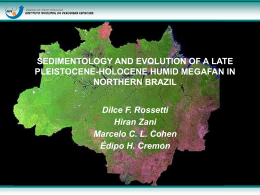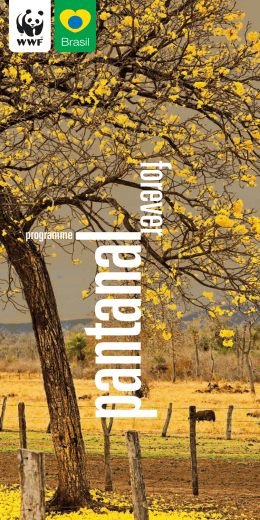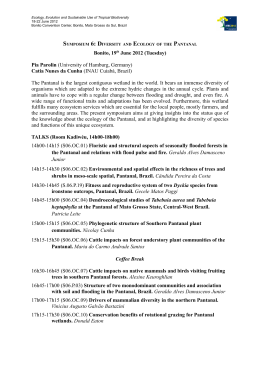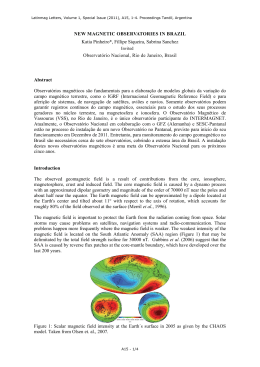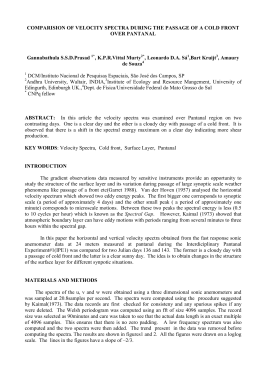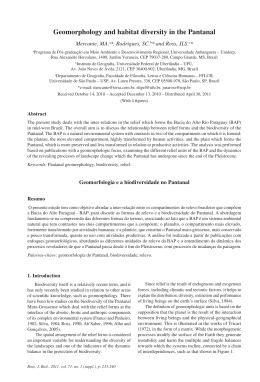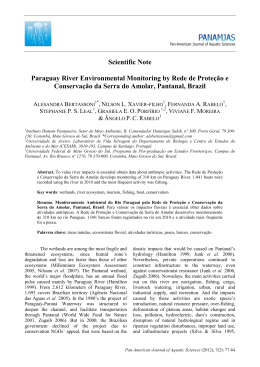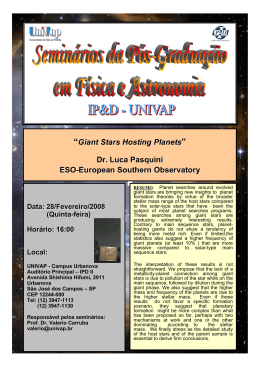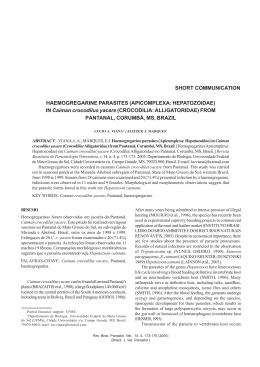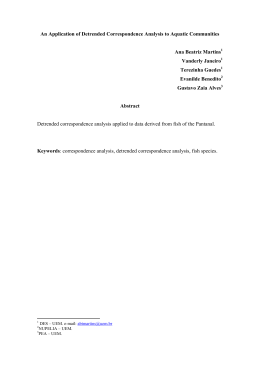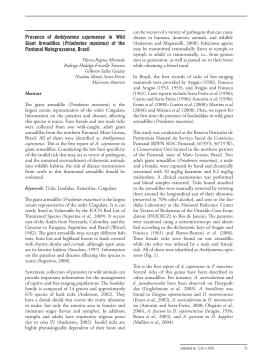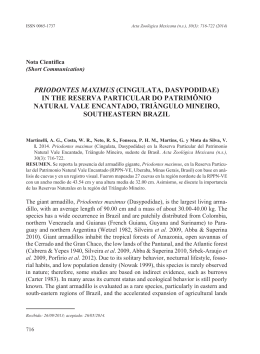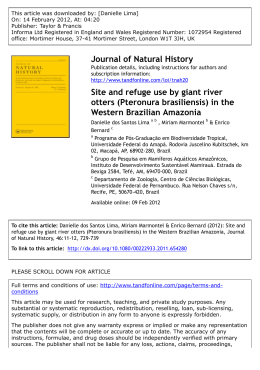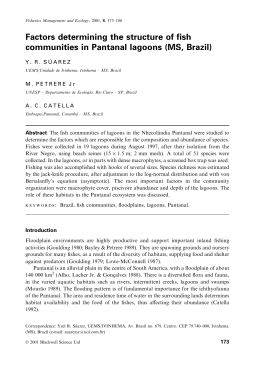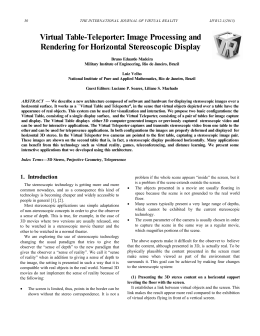Edentata 13 (2012): 72–75 Electronic version: ISSN 1852-9208 Print version: ISSN 1413-4411 http://www.xenarthrans.org SHORT COMMUNICATION New records of giant armadillo Priodontes maximus (Cingulata: Dasypodidae) at Serra do Amolar, Pantanal of Brazil Grasiela Edith de Oliveira Porfirio a,b, ¹, Pedro Sarmento b, Nilson Lino Xavier Filho a, Stephanie Paula da Silva Leal a, Viviane Fonseca Moreiraa, Fernanda Almeida Rabelo a, Joana Cruz c and Carlos Fonseca b Instituto Homem Pantaneiro, Setor de Meio Ambiente, Rua Comendador Domingos Sahib, 300, CEP 79.300-130, Beira Rio, Corumbá, MS, Brasil. E-mail: [email protected], [email protected], stephanie@institutohomempantaneiro. org.br, [email protected], [email protected] B Departamento de Biologia e CESAM – Centro de Estudos do Ambiente e do Mar, Laboratório de Vida Selvagem, 3810-193, Campus de Santiago, Universidade de Aveiro, Portugal. E-mail: [email protected], [email protected] C Environment Department, University of York, Heslington, YO10 5DD, United Kingdom; and CIBIO, Campus Agrário de Vairão, Rua Padre Armando Quintas, 4485-661 Vairão, Portugal. E-mail: [email protected] 1 Corresponding author A Abstract The giant armadillo is one of the least studied South American mammals. It is classified as Vul- nerable due to habitat loss and subsistence hunting. This species has been recorded at several sites within the Pantanal biome of Brazil. We aimed to confirm the species presence in Serra do Amolar, in the western border of the Pantanal. Using camera traps and burrow censuses we confirmed its presence in an area with no previous information. Nevertheless, it is necessary to assess the population status and to gather more information about its ecology in order to contribute to its regional conservation. Keywords: camera trap, conservation, giant armadillo, Priodontes maximus, Serra do Amolar Novos registros do tatu-canastra Priodontes maximus (Cingulata: Dasypodidae) na Serra do Amolar, Pantanal do Brasil Resumo O tatu-canastra é um dos mamíferos sul-americanos menos estudados, e, atualmente, classificado como Vulnerável devido à perda de habitat e à caça de subsistência. A espécie foi registrada em vários locais dentro do bioma Pantanal, Brasil. Nosso objetivo foi confirmar a presença do tatu-canastra na Serra do Amolar, na fronteira oeste do Pantanal. Através de armadilhas fotográficas e censo de tocas pudemos confirmar a presença da espécie em uma área onde não havia informação. No entanto, é necessário avaliar o estado da população e obter mais informações sobre sua ecologia, a fim de contribuir para sua conservação a nível regional. Palavras-chave: armadilhas fotográficas, conservação, Pantanal, Priodontes maximus, Serra do Amolar, tatu-canastra The giant armadillo, Priodontes maximus (Kerr, 1792), is the largest armadillo among the 21 extant species (Abba & Superina, 2010), and is classified by the IUCN Red List of Threatened Species as Vulnerable with a decreasing population trend (IUCN, 2012). Major threats include habitat loss, 72 subsistence hunting, and illegal capture for animal collectors (Fonseca & Aguiar, 2004; Abba & Superina, 2010). Although widely distributed in South America, the giant armadillo seems to occur at low population densities, with a patchy distribution (Aguiar & Edentata 13: 72–75 (2012) Fonseca, 2008). It is solitary, nocturnal or crepuscular, highly fossorial, and rarely observed (Eisenberg & Redford, 1999). Due to its cryptic nature, it is also one of the least studied mammals (Silveira et al., 2009). biome (Bertassoni et al., 2012), since the Brazilian Environment Ministry classifies Serra do Amolar as an area of extremely high importance and priority for biodiversity conservation (MMA, 2007). According to Silveira et al. (2009) the information on giant armadillo ecology has mainly been obtained from indirect signs, sporadic sightings, or dead animals, including in some areas of Pantanal (Schaller, 1983; Alho et al., 1987; Coutinho et al., 1997; Schneider, 2000). In the past few years, the increasing use of camera-trapping provided new evidence of its presence, for example in Chiquitano and Chaco forests of Bolivia (Noss et al., 2004), the grasslandsavannahs of central Brazil (Silveira et al., 2009), the Atlantic forest (Srbek-Araujo et al., 2009), and again in Pantanal (Trolle, 2003; Trolle & Kéry, 2005). Despite the increasing data on its distribution some aspects of its ecology remain poorly understood. We undertook transects along the main roads from March until September 2011 in order to identify potential signs of presence, such as tracks, scats, and burrows. We conducted daily surveys once a month over a period that ranged from two to four days. To complement data collection, we also conducted a camera trapping survey between August and September 2011 in order to assess mammal biodiversity. The rapid expansion of camera trap surveys for detecting elusive species has led to the extensive application of this technique as camera technology has improved and equipment costs decreased (Kelly & Holub, 2008). Twenty-three camera traps (12 Bushnell Trophycam® digital cameras and 11 Tigrinus 6.0 C® analog cameras) were installed along the main dirt roads and in the hills in a trapping grid arrangement with an average of 400 m between cameras. All cameras were programmed to operate continuously (24 h/day) and to take pictures with a minimum interval of 30 s for the digital models, and 5 min for the analog models. The geographic coordinates of camera traps, photographic captures, and presence signs were recorded in a GPS navigator and exported to ArcGis 10 (ESRI®). Sampling effort and sampling success were calculated following Srbek-Araujo & Chiarello (2005). In this study we report the first record from camera trapping of the giant armadillo in the region of Serra do Amolar in the western Pantanal, a biome known for its unique abundance of wildlife (Trolle, 2003) that preserves more than 80% of its original vegetation coverage (Sollmann et al., 2008). Although its presence in the area was already confirmed since the 1970s (Schaller, 1983), we obtained the first record from camera traps for Serra do Amolar. The study was carried out in the 200 km2 Engenheiro Eliezer Batista Private Natural Heritage Reserve (RPPN EEB), located on the western border of Pantanal, between the Paraguay river and lake Mandioré on the Bolivian border, 180 km north of Corumbá (18°05’26”S, 57°18’29”W). The area consists of several rocky peaks (highest altitude of 870 m asl) and flooded plains, and contains a mixture of plant communities, such as moist tropical rainforest plants, semi-arid woodlands, Brazilian Cerrado, and grasslands. Here the ecosystem suffers drastic alterations during the year with an inundation and a desiccation phase, which can alter the spatial ecology of most animal species. Average yearly rainfall is 1,000–1,400 mm, with most precipitation occurring between November and March. Mean temperature is 25 °C but temperatures can fluctuate from 0 to 40 °C. During the rainy season the water level can rise between two and five meters, which isolates most of the peaks. Human presence is low with sparse fishermen settlements along the Paraguay river. The predominant soil in the area is sandy. The PNHR EEB was created in 2008 by private initiative in order to enhance the conservation efforts of Pantanal Matogrossense National Park. In partnership with other private institutions the PNHR EEB also takes part of Rede de Proteção e Conservação da Serra do Amolar (RPCSA), a multiorganizational conservation framework for Serra do Amolar that legally protects 209,000 ha of Pantanal With an effort of 550 trap-days we obtained two captures of giant armadillo (0.36 captures per 100 camera-days) from camera traps installed on one of the roads and in the valley (Fig. 1). The animals were registered at night, and because of their position we were not able to determine their sex. The giant armadillo was the only Xenarthra species recorded on this camera trapping effort but other species have been detected by camera traps previously installed in the protected area, such as the nine-banded armadillo (Dasypus novemcinctus), sixbanded armadillo (Euphractus sexcinctus), and giant anteater (Myrmecophaga tridactyla) (Instituto Homem Pantaneiro, unpublished data). Although further studies are planned to gather information about the ecology and conservation status of these Xenarthra species, they seem to occur at low densities at the PNHR EEB, since the area has large flooded fields in proportion to the dry lands. Our census effort comprised approximately 40 hours, and we identified three distinct burrows along two main roads of the RPPN EEB. The first burrow was located under an anthill, and there were three entrances around the mound. The second burrow was found on the road, under a fallen trunk, and the third burrow was found beside the dirt road, in a sand bank formed due to the accumulation of soil taken to open the road (Fig. 1). The point where this G. E. O. Porfirio et al. : Short Communication / New records of giant armadillo Priodontes maximus... 73 hole was dug was covered by vegetation, and there were no signs of ant or termite mounds. Although in recent years new information has been obtained about giant armadillos, this species is still poorly known. Most of this knowledge has been obtained by the use of camera trapping methodology. In this context, camera traps have been shown to be an efficient and non-invasive tool to study important ecological aspects of the species such as activity patterns, density estimates, habitat use, home range, and interaction with other species (Noss et al., 2004; Silveira et al., 2009; Srbek-Araujo et al., 2009). In a study conducted in the upper Rio Negro Basin, Trolle (2003) concluded that camera trapping allows analyzing the field biology of many species to a degree of precision that had not been published before in the region of the study area. Yet, he found only one old burrow of a giant armadillo in Acuri (Attalea phalerata) forest, and the species was never recorded by camera trapping, seeming to be rare. In a review, Rodrigues et al. (2002) detailed other areas within the Pantanal where giant armadillo presence was confirmed such as the upper Paraguai river basin, in the region of Manso river hydroelectric power plant (Schneider, 2000), Serra do Amolar, in Acurizal ranch (Schaller, 1983), Chapada Figure 1. 74 Location of Engenheiro Eliezer Batista Protected Area (EEB PNHR), and locations of giant armadillo captures and signs. dos Guimarães (Cope, 1889), and Nhumirim ranch (Alho et al., 1987). Also, a giant armadillo was photographed with a conventional camera at Fazenda 4 Cantos, in the Pantanal of Nhecolândia (18°36’54”S, 56°16’59”W), in 2011. The picture was taken by Mr. Pablo Lima, one of the farm owners, and shown to one of the authors (GEOP). The species was also registered by Trolle (2003) in the upper Rio Negro basin, and in the northern Pantanal by Trolle & Kéry (2005) (Fig. 2). The most recent previous sign of giant armadillos in Serra do Amolar dates back to the late 1970s, at the Acurizal ranch, 30 km north of our study area. At that time, Schaller (1983) concluded that this species was very rare or recently extinct on the ranch, and only a few abandoned burrows were found in Cerrado and gallery forest. Our research confirms the species’ presence in Serra do Amolar both by signs and by photos. Nevertheless, it is necessary to gather information on habitat use, population density, interactions, and feeding ecology, as well as to assess its population status at Serra do Amolar in order to fill gaps in scientific knowledge and to strategically contribute to conservation planning. Figure 2. Giant armadillo detections in the Brazilian Pantanal. 1: Schneider (2000); 2: Cope (1889); 3: Trolle & Kéry (2005); 4: Schaller (1983); 5: this study; 6: P. Lima, pers. comm.; 7: Alho et al. (1987); 8: Trolle (2003). Edentata 13: 72–75 (2012) Acknowledgements This study is part of an ongoing project being conducted in Engenheiro Eliezer Batista Private Natural Reserve which, is funded by EBX holding Brazil and supported by Instituto Homem Pantaneiro. We thank University of Aveiro and FCT for financial support and scholarship grants provided to the first author (SFRH/BD/51033/2010). We also thank André Wagner Amorim Brandão, Franciane Souza da Silva, and Ramão Feitosa for field assistance. References Abba, A. M. & M. Superina. 2010. The 2009/2010 armadillo Red List assessment. Edentata 11: 135–184. Aguiar, J. M. & G. A. B. Fonseca. 2008. Conservation status of the Xenarthra. Pp. 215–231 in: The biology of the Xenarthra (S. F. Vizcaíno & W. J. Loughry, eds.). University Press of Florida, Gainesville. Alho, C. J. R. Jr., T. E. Lacher, J. M. S. Campos & H. C. Gonçalves. 1987. Mamíferos da Fazenda Nhumirim, sub-região da Nhecolândia, Pantanal do Mato Grosso do Sul: levantamento preliminar de espécies. Revista Brasileira de Biologia 48: 213–225. Bertassoni, A., N. L. Xavier-Filho, F. A. Rabelo, S. P. S. Leal, G. E. O. Porfirio, V. F. Moreira & A. P. Rabelo. 2012. Paraguay river environmental monitoring by Rede de Proteção e Conservação da Serra do Amolar, Pantanal, Brazil. PanAmerican Journal of Aquatic Sciences 7: 77–84. Cope, E. D. 1889. On the Mammalia obtained by the naturalist exploring expedition to southern Brasil. American Naturalist 23: 128–150. Coutinho, M. E., Z. M. S. Campos, G. M. Mourão & R. A. Mauro. 1997. Aspectos ecológicos dos vertebrados terrestres e semi-aquáticos no Pantanal. Pp. 183–322 in: Plano de conservação da Bacia do Alto Paraguai (Pantanal) – PCBAP: Diagnóstico dos meios físicos e bióticos: meio biótico. Ministério do Meio Ambiente, dos Recursos Hídricos e da Amazônia Legal, Brasília, Brasil. Eisenberg, J. F. & K. H. Redford. 1999. Mammals of the Neotropics, Volume 1. The Northern Neotropics: Panama, Colombia, Venezuela, Guyana, Suriname, French Guyana. The University of Chicago Press, Chicago. 609 pp. Fonseca, G. A. B. & J. M. Aguiar. 2004. The 2004 Edentate Species Assessment Workshop. Edentata 6: 1–26. IUCN 2012. The IUCN Red List of Threatened Species. Version 2012.1. <http://www.iucnredlist.org>. Downloaded on 31 July 2012. Kelly, M. J. & E. L. Holub. 2008. Camera trapping of carnivores: trap success among camera trap types and across species, and habitat selection by species, on Salt Pond Moutain, Gile County, Virginia. Northeastern Naturalist 15: 249–262. MMA (Ministério do Meio Ambiente). 2007. Áreas prioritárias para a conservação, uso sustentável, e repartição de benefícios da Biodiversidade Brasileira. Ministério do Meio Ambiente, Brasília, Brasil. 301 pp. Noss, A. J., P. Peña & D. I. Rumiz. 2004. Camera trapping Priodontes maximus in the dry forest of Santa Cruz, Bolivia. Endangered Species Update 2: 43–52. Rodrigues, F. H., I. M. Medri, W. M. Tomas & G. M. Mourão. 2002. Revisão do conhecimento sobre ocorrência e distribuição de mamíferos do Pantanal. Embrapa Pantanal, Documentos 38. 41 pp. Schaller, G. B. 1983. Mammals and their biomass on a Brazilian ranch. Arquivos de Zoologia 31: 1–36. Schneider, M. 2000. Mastofauna. Pp. 217–238 in: Fauna silvestre da região do rio Manso, MT (C. J. R. Alho, ed.). Edições Ibama, Brasília, Brasil. Silveira, L., A. T. A. Jácomo, M. M. Furtado, N. M. Torres, R. Sollmann & C. Vynne. 2009. Ecology of the giant armadillo (Priodontes maximus) in the grasslands of central Brazil. Edentata 8–10: 25–34. Sollmann, R., N. M. Tôrres & L. Silveira. 2008. Jaguar conservation in Brazil: the role of protected areas. Cat News Special Issue 4: 15–20. Srbek-Araujo, A. C. & A. G. Chiarello. 2005. Is camera trapping an efficient method for surveying mammals in Neotropical forests? A case study in south-eastern Brazil. Journal of Tropical Ecology 21: 1–5. Srbek-Araujo, A. C., L. M. Scoss, A. Hirsch & A. G. Chiarello. 2009. Records of the giant armadillo Priodontes maximus (Cingulata: Dasypodidae) in the Atlantic forest: are Minas Gerais and Espirito Santo the last stronghold of the species? Zoologia 26: 461–468. Trolle, M. 2003. Mammal survey in the southeastern Pantanal, Brazil. Biodiversity and Conservation 12: 823–836. Trolle, M. & M. Kéry. 2005. Camera trap study of ocelot and other secretive mammals in the northern Pantanal. Mammalia 69: 405–41. Received: 25 July 2012; Accepted: 11 September 2012 G. E. O. Porfirio et al. : Short Communication / New records of giant armadillo Priodontes maximus... 75
Download
